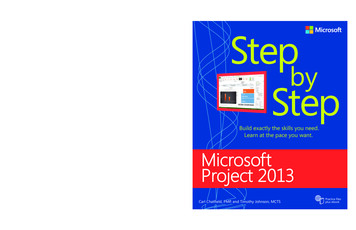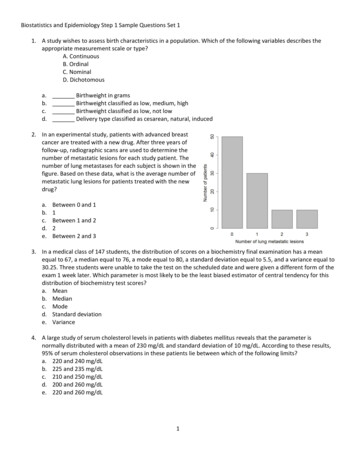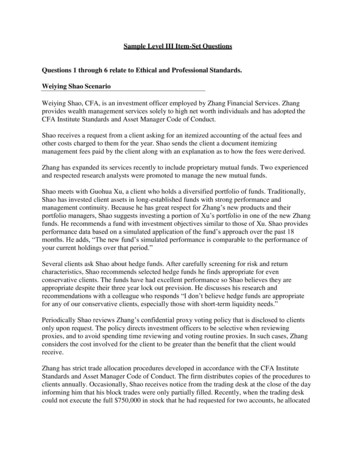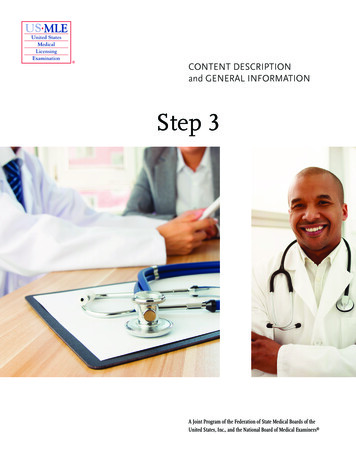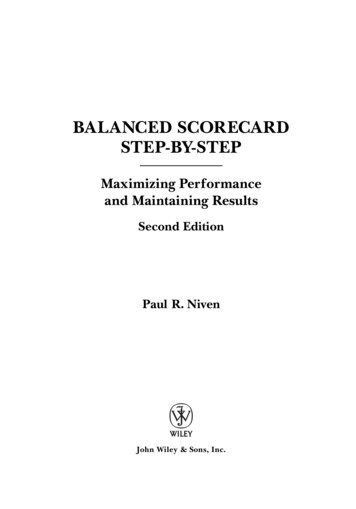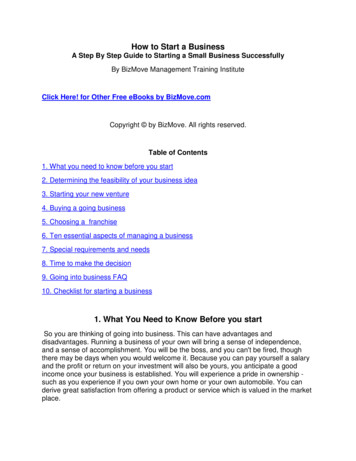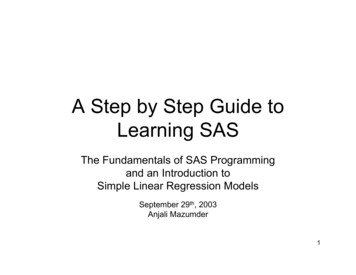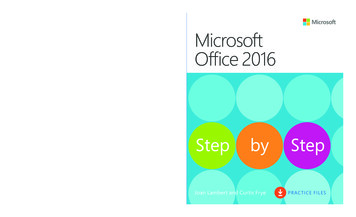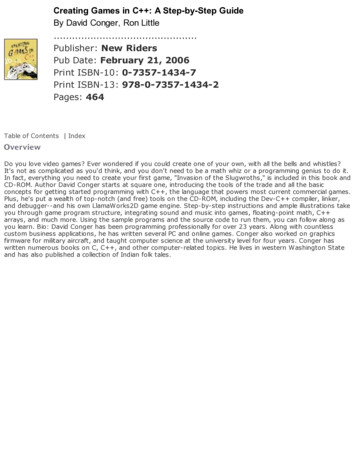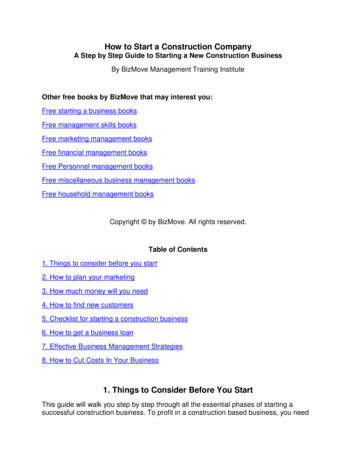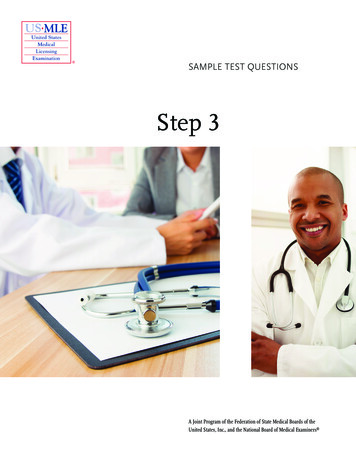
Transcription
SAMPLE TEST QUESTIONSStep 3A Joint Program of the Federation of State Medical Boards of theUnited States, Inc., and the National Board of Medical Examiners
This booklet was updated November 2020.Copyright 2020 by the Federation of State Medical Boards of the United States, Inc. (FSMB), andNational Board of Medical Examiners (NBME ). All rights reserved. Printed in the United States ofAmerica. The United States Medical Licensing Examination (USMLE ) is a joint program of the FSMB andNBME.
CONTENTSUSMLE Step 3 Multiple Choice Test Question Formats . 2Introduction to USMLE Step 3 Sample Test Questions. 6USMLE Step 3 Normal Laboratory Values. 7Answer Form for USMLE Step 3 Sample Questions. 10USMLE Step 3 Sample Test Questions . 11Answer Key for USMLE Step 3 Sample Questions . 79
USMLE STEP 3 MULTIPLE-CHOICE TEST QUESTION FORMATSThe following are strategies for answering one-best-answer questions (eg, Single Items, MultipleItem Sets, and Sequential Item Sets): Read each patient vignette and question carefully. It is important to understand what is beingasked. Try to generate an answer and then look for it in the option list. Alternatively, read each option carefully, eliminating those that are clearly incorrect. Of theremaining options, select the one that is most correct. If unsure about an answer, it is better to guess since unanswered questions are automaticallycounted as wrong answers.Patient Scenario FormatsPatient scenarios for any Single Item or Sequential Item Set may be provided in either Vignette(paragraph) format, or in Chart/Tabular format. Questions written in Chart/Tabular format willcontain relevant patient information in list form, organized in clearly marked sections for ease ofreview. Familiar medical abbreviations may be used within Chart/Tabular format questions.Single-Item QuestionsA single patient-centered scenario is associated with one question followed by four or moreresponse options. The response options for all questions are lettered (ie, A, B, C, D, E). You arerequired to select the best answer to the question. Other options may be partially correct, butthere is only ONE BEST answer. This is the traditional, most frequently used multiple-choicequestion format on the examination.Example Question 11. A 30-year-old man comes to the emergency department because of an acute episode of renalcolic. Medical history is remarkable for episodes of painful urination and passing of what hecalls "gravel in my urine." Urinalysis demonstrates microscopic hematuria with some crystalluriaand no casts. Supine x-ray of the abdomen shows no abnormalities. A 4-mm renal calculus isdetected in the distal right ureter on ultrasonography. There is no evidence of dilation of thecollecting system. The patient's pain is responsive to narcotic medication. In addition toadministering intravenous fluids, which of the following is the most appropriate next step?A. Acidification of urine by drinking cranberry juiceB. Cystoscopic removal of the calculusC. Cystoscopic ureteral lavageD. Shock wave lithotripsyE. Straining of the urine(Answer: E)2
Multiple Item SetsA single patient-centered scenario may be associated with two or three consecutive questionsabout the information presented. Each question within these sets is associated with the patientscenario and is independent of the other question(s) in the set. The questions within this type offormat are designed to be answered in any order. You are required to select the ONE BEST answerto each question.Example Questions 2 to 3A 52-year-old man returns to the office for reevaluation of an ulcer on his right great toe. Thepatient has a 15-year history of diabetes mellitus and takes glipizide and rosiglitazone. He firstnoticed the ulcer 2 months ago. One month ago, a 14-day course of oral amoxicillin-clavulanatetherapy was prescribed. He has smoked one pack of cigarettes daily for the past 37 years. He is178 cm (5 ft 10 in) tall and weighs 102 kg (225 lb); BMI is 32 kg/m2. Today, vital signs aretemperature 38.8 C (101.8 F), pulse 96/min, respirations 12/min, and blood pressure 130/85 mmHg. Physical examination of the right great toe discloses a 1.5-cm nontender ulcer with a depth of0.5 cm, a moist base, yellow exudate, and surrounding erythema to the level of the malleoli.Vibration sense and sensation to monofilament examination are absent. Pulses are diminished inboth feet. Capillary refill time is 2 seconds in the right great toe. Urinalysis discloses 3 protein.2. Which of the following historical factors or physical examination findings is most stronglyassociated with development of this patient's foot ulcer?A. Diminished pedal pulsesB. Neurologic findingsC. The patient's weightD. ProteinuriaE. Tobacco use(Answer: B)3. Which of the following is the most appropriate action at this time?A. Begin aggressive debridement in the officeB. Begin intravenous antibiotic therapyC. Refer the patient for transmetatarsal amputationD. Schedule the patient for a third-degree skin graftE. Switch the amoxicillin-clavulanate to oral ciprofloxacin(Answer: B)3
Sequential Item SetsA single patient-centered scenario may be associated with two or three consecutive questionsabout the information presented. Each question is associated with the initial patient scenario butis testing a different point. You are required to select the ONE BEST answer to each question.Questions are designed to be answered in sequential order. You must click "Proceed to Next Item"to view the next question in the set; once you click on this button, the next question will bedisplayed, and you will not be able to add or change an answer to the previous question.Example Questions 4 to 5A 2-year-old girl is brought to the office by her mother for evaluation of fever. You have been thegirl's physician since birth. While in the office, the girl stiffens and then has bilateral, symmetricalshaking of her upper and lower extremities; she becomes mildly cyanotic. The episode lasts forapproximately 45 seconds, after which she becomes relaxed and appears to fall asleep. Vital signsat this time are temperature 40.0 C (104.0 F), pulse 120/min, and respirations 40/min. On physicalexamination she has a generally pink complexion and flushed cheeks. She is limp and somnolentand responds with a cry to noxious stimulus. Tympanic membranes are inflamed bilaterally, nosehas a scant, clear discharge, and throat is mildly erythematous. Lungs are clear to auscultationexcept for transmitted upper airway sounds. Heart has rapid rate with a grade 1/6 systolic murmurat the left sternal border. Complete blood count, blood culture, lumbar puncture, and catheterizedurine specimen are obtained and sent for stat analysis. Acetaminophen is administered by rectalsuppository. Thirty minutes later the patient awakens and is smiling. She is afebrile. Additionalhistory discloses that she was born at term, she had an uneventful neonatal course, she hasnormal growth and development, and vaccinations are up-to-date. She has never had an episodesimilar to this. Initial laboratory results are shown:BloodWBCNeutrophils, segmentedNeutrophils, bandsLymphocytesMonocytesCerebrospinal fluidUrinalysis10,400/mm325%5%65%5%0 RBC/mm3NormalOther laboratory studies are pending.4. In addition to ampicillin for otitis media and acetaminophen, this child also should receivewhich of the following?A. Oral ethosuximideB. Oral phenobarbitalC. Oral phenytoinD. Rectal diazepamE. No additional medications(Answer E)4
5. Two weeks later the patient is brought to the office for a follow-up visit. Her mother says thatshe is doing well and she has had no recurrence of her symptoms. Examination of the earsshows resolution of the otitis media. Which of the following is the most important diagnosticstep at this time?A. Audiology testingB. Cognitive testingC. CT scan of the headD. EEGE. No additional testing(Answer E)5
INTRODUCTION TO USMLE STEP 3 SAMPLE TEST QUESTIONSThe following pages include 137 sample test questions. Please note that reviewing the sample questions isnot a substitute for acquainting yourself with the test software. You should run the Step 3 tutorial andpractice test questions that are provided on the USMLE website well before your test date. The samplematerials on the USMLE website include additional item formats that do not appear in this booklet (eg,items with associated audio findings). Note that the function of items such as pharmaceutical ads,abstracts, and sequential item sets is unique in an examination interface. You should become familiar withall test question/item formats as they will be used in the actual examination.In addition, the computer-based case simulation (CCS) format you will see on an actual Step 3examination is not represented in this booklet. You must become familiar with the CCS format by readinginformation available in the USMLE Content Description and General Information booklet and bypracticing with sample CCS cases before you take the Step 3 examination; the information and thepractice materials are available on the USMLE Web site (www.usmle.org).These sample questions are illustrative of the types of questions used in the Step 3 examination. Althoughthe questions exemplify content on the examination, they may not reflect the content coverage onindividual examinations. Questions are grouped together by the content appropriate for eachexamination day in the same manner as in the actual computer-administered test blocks. In the actualexamination, the questions will be presented one at a time in a format designed for easy on-screenreading, including use of a panel for the table of normal laboratory values (included here on pages 7–9)and some pictorials. Photographs, charts, and x-rays referred to in this booklet are not of the same qualityas the pictorials used in the actual examination. In addition, you will have the capability to adjust thebrightness and contrast of pictorials on the computer screen.To take the following sample test questions as they would be timed in the actual examination, you shouldallow a maximum of 1 hour for each of the Foundations of Independent Practice (FIP) blocks, and amaximum of 45 minutes for each of the Advanced Clinical Medicine (ACM) blocks, for a total of 3 hours30 minutes. Please be aware that most examinees perceive the time pressure to be greater during anactual examination. An answer sheet for recording answers for this practice is provided on page 10. Ananswer key is provided on page 79. In the actual examination, answers will be selected on the screen; noanswer form will be provided.6
USMLE LABORATORY VALUESReference RangeSERUMGeneral Chemistry:ElectrolytesSodium (Na )Potassium (K )Chloride (Cl–)Bicarbonate (HCO3–)Urea nitrogenCreatinineGlucoseCalciumMagnesium (Mg2 )Phosphorus (inorganic)Hepatic:Alanine aminotransferase (ALT)Aspartate aminotransferase (AST)Alkaline phosphataseAmylaseBilirubin, Total // DirectProteins, riglyceridesIron Studies:FerritinIronTotal iron-binding capacityTransferrinSIReference RangeSI Reference Intervals136–146 mEq/L3.5–5.0 mEq/L95–105 mEq/L22–28 mEq/L7–18 mg/dL0.6–1.2 mg/dLFasting: 70–100 mg/dLRandom, non-fasting: 140 mg/dL8.4–10.2 mg/dL1.5–2.0 mg/dL3.0–4.5 mg/dL136–146 mmol/L3.5–5.0 mmol/L95–105 mmol/L22–28 mmol/L2.5–6.4 mmol/L53–106 μmol/L3.8–5.6 mmol/L 7.77 mmol/L2.1–2.6 mmol/L0.75–1.0 mmol/L1.0–1.5 mmol/L10–40 U/L12–38 U/L25–100 U/L25–125 U/L0.1–1.0 mg/dL // 0.0–0.3 mg/dL6.0–7.8 g/dL3.5–5.5 g/dL2.3–3.5 g/dL10–40 U/L12–38 U/L25–100 U/L25–125 U/L2–17 μmol/L // 0–5 μmol/L60–78 g/L35–55 g/L23–35 g/LNormal: 200 mg/dLHigh: 240 mg/dL40–60 mg/dL 160 mg/dLNormal: 150 mg/dLBorderline: 151–199 mg/dL 5.2 mmol/L 6.2 mmol/L1.0–1.6 mmol/L 4.2 mmol/L 1.70 mmol/L1.71–2.25 mmol/LMale: 20–250 ng/mLFemale: 10–120 ng/mLMale: 65–175 µg/dLFemale: 50–170 μg/dL250–400 µg/dL200–360 mg/dL20–250 μg/L10–120 μg/L11.6–31.3 μmol/L9.0–30.4 μmol/L44.8–71.6 μmol/L2.0–3.6 g/L7Continued on Next Page
USMLE LABORATORY VALUES (continued)Reference RangeSI Reference IntervalsMale: 4–25 mIU/mLFemale: premenopause 4–30 mIU/mLmidcycle peak 10–90 mIU/mLpostmenopause 40–250 mIU/mLMale: 6–23 mIU/mLFemale: follicular phase 5–30 mIU/mLmidcycle 75–150 mIU/mLpostmenopause 30–200 mIU/mLFasting: 5 ng/mLProvocative stimuli: 7 ng/mLMale: 17 ng/mLFemale: 25 ng/mL0800 h: 5–23 μg/dL1600 h: 3–15 μg/dL2000 h: 50% of 0800 h0.4–4.0 μU/mL100–200 ng/dL25%–35%5–12 μg/dL0.9–1.7 ng/dL8%–30% of administered dose/24 h10–60 pg/mLMale: 3.0–10.0 mg/24 hFemale: 2.0–8.0 mg/24 hMale: 8–20 mg/24 hFemale: 6–15 mg/24 h4–25 IU/L4–30 IU/L10–90 IU/L40–250 IU/L6–23 IU/L5–30 IU/L75–150 IU/L30–200 IU/L 5 μg/L 7 μg/L 17 μg/L 25 μg/L138–635 nmol/L82–413 nmol/LFraction of 0800 h: 0.500.4–4.0 mIU/L1.5–3.1 nmol/L0.25–0.3564–155 nmol/L12.0–21.9 pmol/L0.08–0.30/24 h10–60 ng/L8.2–27.6 μmol/24 h5.5–22.0 μmol/24 h28–70 μmol/24 h21–52 μmol/24 h76–390 mg/dL0–380 IU/mL650–1500 mg/dL50–300 mg/dL0.76–3.90 g/L0–380 kIU/L6.5–15.0 g/L0.5–3.0 g/LMale: 97–137 mL/minFemale: 88–128 mL/minMale: 25–90 U/LFemale: 10–70 U/L45–200 U/L275–295 mOsmol/kg H2O3.0–8.2 mg/dL97–137 mL/min88–128 mL/min25–90 U/L10–70 U/L45–200 U/L275–295 mOsmol/kg H2O0.18–0.48 mmol/LGASES, ARTERIAL BLOOD (ROOM AIR)PO 2PCO2pH75–105 mm Hg33–45 mm Hg7.35–7.4510.0–14.0 kPa4.4–5.9 kPa[H ] 36–44 nmol/LCEREBROSPINAL FLUIDCell countChlorideGamma globulinGlucosePressureProteins, total0–5/mm3118–132 mEq/L3%–12% total proteins40–70 mg/dL70–180 mm H2O 40 mg/dL0–5 106/L118–132 mmol/L0.03–0.122.2–3.9 mmol/L70–180 mm H2O 0.40 g/LEndocrine:Follicle-stimulating hormoneLuteinizing hormoneGrowth hormone - arginine stimulationProlactin (hPRL)Cor
practicing with sample CCS cases before you take the Step 3 examination; the information and the practice materials are available on the USMLE Web site (www.usmle.org). These sample questions are illustrative of the types of questions used in the Step 3 examination. AlthoughFile Size: 1MBPage Count: 71

